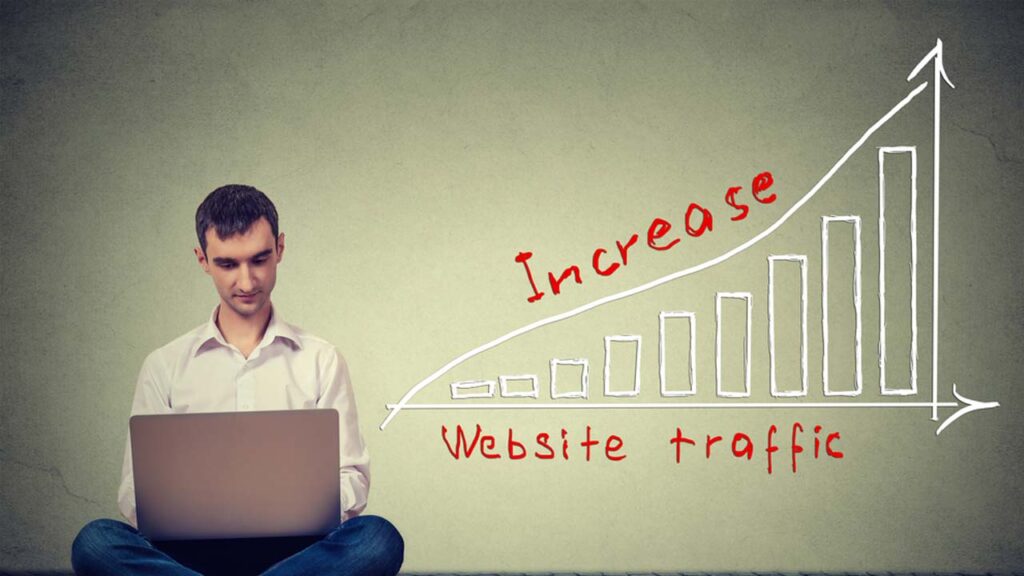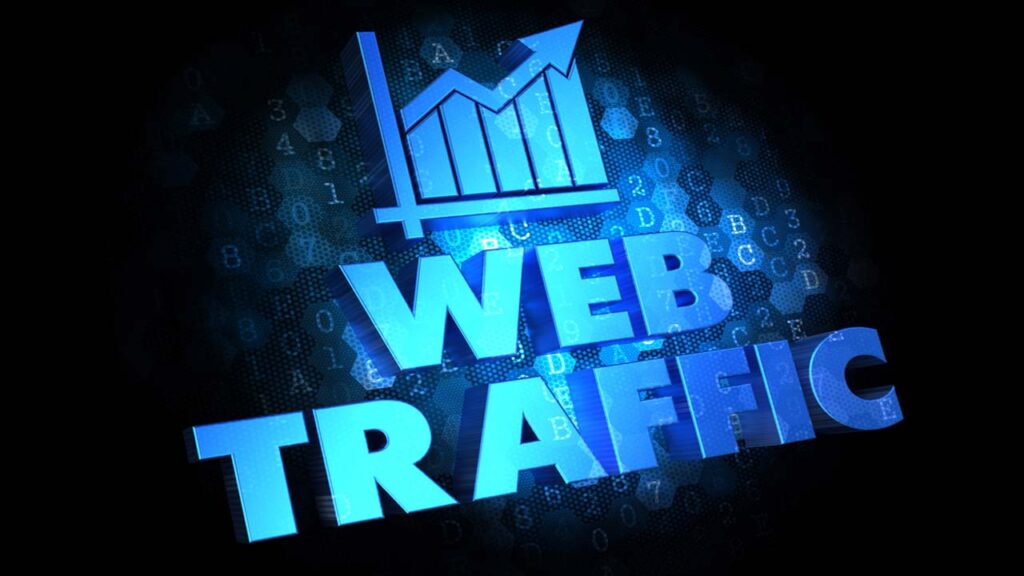5 Effective Strategies: How to Increase the Traffic on Website Without Overwhelm
Brett Lewis
Lead Generation - June 17, 2024

Curious about “how to increase the traffic on website”? Boost your digital presence with essential tactics such as SEO mastery, compelling content, and social media engagement. This guide cuts through the noise to give you straightforward digital marketing strategies for drawing more visitors and generating leads—let’s get started.
Key Takeaways
- Optimizing your website with SEO practices like keyword research, on-page optimization, and backlink building can attract more organic traffic without paying for ads.
- Engaging and educational content is key to retaining visitors and boosting traffic; types of content can include blog posts, videos, and downloadable resources.
- Leveraging social media through consistent posting, paid ads, and influencer marketing can significantly expand your reach and drive traffic to your website.
Mastering Search Engine Optimization (SEO) for Increased Traffic

If you’ve been in the digital space, you’ve probably heard of SEO. But do you know how powerful it can be in driving organic traffic to your website? SEO, or Search Engine Optimization, is not just a buzzword. It’s a tactical approach to make your website more appealing to search engines, thus attracting more visitors without shelling out for ads.
Understanding its functioning is simple; it primarily consists of three main components:
- Keyword research: helps you understand what your potential visitors are searching for.
- On-page optimization: ensures that your site is search-engine-friendly.
- Backlink building: enhances your website’s authority in the eyes of search engines.
Together, these elements make your website more visible on search engine results pages (SERPs), driving a wave of traffic your way. Utilizing tools like Google Search Console can further enhance your site’s visibility on SERPs.
Keyword Research Mastery
Keyword research is like treasure hunting. You’re looking for those golden keywords that your target audience is using to search for information. And when you find them, you can use them to attract high-traffic potential to your website. With tools like Google Analytics and Ahrefs, you can uncover these gems and understand your competitors’ keyword usage, keyword search volumes, and other strategic data that can inform your keyword selection.
Keep in mind, however, that not all keywords carry the same weight. Long-tail keywords, for instance, can be your secret weapon. They are longer and more specific keyword phrases that visitors are more likely to use when they’re closer to a point-of-purchase or when they’re using voice search. They might not bring in the highest volume of traffic, but they often bring in the most relevant traffic, making them a valuable component of your SEO strategy.
On-Page SEO Essentials
The practice of on-page SEO involves enhancing individual web pages for search engine visibility. This means making sure your content is high-quality, relevant, and easy for search engines to understand. One of the most critical aspects of on-page SEO is the use of meta descriptions. These short snippets provide a summary of your webpage’s content and can significantly impact click-through rates from SERPs, boosting your website’s traffic.
Furthermore, headers like H1, H2, and H3 tags also hold significant importance. Including targeted keywords in these tags can lead to better SEO outcomes. In addition, optimizing your images for search engine visibility is just as important. This includes using relevant alt-text and file names that describe the image content. All these elements, when combined, contribute to a robust on-page SEO strategy that can drive more traffic to your website.
Backlink Building Techniques
Think of the internet as a bustling city and backlinks as the roads that connect different parts of this city. The more roads leading to your website, the more traffic you’re likely to get. This is precisely the reason why backlink building holds such importance in SEO. But how do you build these roads, or rather, backlinks?
One effective technique is forming partnerships with other websites and engaging in backlink exchanges. This can lead to a significant increase in website views, as it offers a mutually beneficial exchange. Another powerful strategy is guest posting. By contributing high-quality content to other websites, you can generate backlinks, boost referral traffic, and increase your SERP rankings.
The key here is to acquire backlinks from credible sites with high Domain Authority as it contributes to increasing your own Domain Authority and thus, your search engine rankings.
Crafting Compelling Content That Resonates

Even though SEO can attract visitors to your website, it’s the engaging content that retains them and ensures their return. Crafting high-quality, relevant content that aligns with your audience’s interests is a surefire way to boost engagement and repeat visits. So, what type of content does your audience connect with? It could be anything from blog posts and video marketing to educational resources.
Understanding your buyer persona is key to creating content that hits the mark. This could involve creating:
- Infographics
- Downloadable guides
- Templates
- Webinars
- And more
Not only does this kind of content lead to more traffic, but websites with blog content also generate significantly more website traffic through search engine-indexed pages.
Furthermore, leveraging your current readers and customers to promote new content can effectively increase your website traffic. An email newsletter, for instance, can drive significant traffic to your website, particularly when it includes updated content that caters to topics audiences might not actively search for.
Blog Posts That Engage
Blog posts serve as a potent tool for engaging your audience, particularly when they resolve audience queries or address their issues. How-to posts, guides, and lists are particularly effective formats for engaging blog content. However, creating engaging content is only half the battle. Drawing traffic to these posts is the other half, and that’s where compelling headlines come in. A headline that highlights the problem solved by the post can significantly increase click-through rates, driving more traffic to your website.
Listening to your audience can also provide valuable insights for content creation. Identifying common questions in forums like Quora and Reddit can inform the creation of relevant content that resonates with your audience. And remember, engagement is a two-way street. Actively responding to comments on blog posts can create a two-way conversation and encourage further engagement.
Leveraging Video Marketing
In the rapidly progressing digital age of today, audiences frequently favor video content over text. This makes video content a powerful tool for attracting more visitors and keeping them engaged on your website. Engaging viewers with video content can extend website visits, which in turn, can boost your website’s organic search visibility.
By incorporating videos into your landing pages and blog posts, you can improve your visibility in Google search results. Additionally, this can also help in engaging visitors and prolonging their stay on your site. So why not leverage video marketing to draw more traffic to your website?
Educational Content as a Magnet
Educational content also serves as an effective draw for website traffic. By providing helpful resources such as relevant websites, courses, certifications, articles, editorial calendar templates, idea generators, assessments, quizzes, and calculators, you can attract more visitors to your site.
You can attract an audience that’s eager to learn. These educational tools can also attract traffic to your website.
But the benefits of educational content don’t end there. Top-notch, evergreen educational content not only draws visitors to your website but also earns backlinks, which increases traffic over time. So, if you’re looking to increase your website traffic, consider investing in educational content.
Utilizing Social Media Platforms for Wider Reach

In the interconnected digital era, social media platforms present an unrivaled chance to engage a broader audience and increase both website traffic and web traffic. Whether it’s creating compelling visual content, leveraging memes, or utilizing social share buttons, each strategy can contribute to a significant increase in website traffic. With platforms like Facebook boasting massive user bases and adults spending a significant amount of time on social media daily, the potential to generate traffic through these channels is immense.
But social media is not just about organic reach. Paid social media ads can help you target new audiences and achieve various goals, such as increasing brand awareness or generating leads. Additionally, harnessing the power of influencers can expose your website to new audiences and drive traffic through influencer recommendations and user-generated content.
Building a Social Media Presence
Establishing a purposeful social media presence is imperative for interacting with your target audience and steering traffic towards your website. But how do you build a powerful social media presence? It involves:
- Consistent posting
- Customizing post frequency for platform algorithms
- Creating timely content with compelling visuals
- Utilizing interactive features like Instagram Stories or Twitter polls to engage with your audience and influence content decisions.
However, it’s important to remember that not all social media platforms are created equal. While Facebook is the most popular platform for social media referrals, platforms like Instagram and Pinterest usually drive less traffic to external websites. Leveraging social proof, such as testimonials and reviews, on social media platforms can also build trust with your audience, leading to increased traffic to your website.
Paid Social Media Ads
Despite the value of organic social media reach, paid social media ads can amplify your reach by crafting highly targeted campaigns for your potential customers. Tools like Shopify Audiences can help you find relevant buyers and lower advertising costs through custom audience lists.
Paid social media ads can help you reach new audiences and achieve various goals, such as increasing brand awareness or generating leads. By targeting the right audience with the right message, paid social media ads can drive a significant amount of traffic to your website.
Harnessing the Power of Influencers
Influencer marketing revolves around forging relationships to introduce your online store to new demographics. Here are the steps to implement influencer marketing:
- Feature influencers in a blog post.
- Share the blog post with the influencers.
- The influencers will spread the word to their followers.
- This will increase your website’s traffic.
But the power of influencers doesn’t end there. User-generated content and recommendations from influencers can be utilized in retargeting campaigns to enhance product credibility and encourage re-engagement. This strategy not only exposes your website to new audiences but also drives repeat traffic from existing ones.
Paid Advertising: A Quick Traffic Booster

Even though organic methods for driving traffic are successful, they usually require time to produce results. If you’re looking for a quick traffic booster, paid advertising might be the answer. Paid advertising, or pay-per-click advertising, enables advertisers to reach new audiences and achieve various goals such as increasing brand awareness, generating leads, boosting sales, improving conversion rates, and enhancing customer retention.
Be it via search, display, or social ads, paid advertising channels can draw in highly specific visitors on a large scale. But before initiating a paid advertising campaign, understanding the objectives and evaluating the pros and cons of each paid media channel are essential for strategic success.
Search Ads That Convert
Search ads are a powerful tool in your paid advertising arsenal. By targeting high commercial intent keywords, search ads can drive traffic and potential customers to your website. Careful keyword selection and bid management, especially for branded keywords, are crucial to target users with high purchase intent for better advertising ROI.
Responsive search ads are an effective retargeting tactic that adjusts content and format based on previous interactions and the consumer’s current context, significantly increasing conversions. In fact, Google has estimated that paid search advertising can return $2 for every $1 spent, indicating a strong potential for ROI.
Retargeting for Re-engagement
Retargeting campaigns are all about re-engaging previous visitors of your website. These campaigns use cookies to follow your audience around the web, showing them targeted ads that remind them of your website and encourage them to return.
Responsive search ads and Facebook Dynamic Ads are particularly effective retargeting tactics. Responsive search ads auto-adjust content and format based on previous interactions and the consumer’s current context, while Facebook Dynamic Ads showcase relevant products or content to users who have previously visited your website. These strategies can significantly increase conversion rates and drive repeat traffic to your website.
Optimizing User Experience for Repeat Visits

Lastly, enhancing user experience is a key strategy for steering traffic towards your website. A better user experience encourages visitors to spend more time on your site, increasing the likelihood of repeat visits and promoting word-of-mouth. And it’s not just about making your website look good. It’s also about making it functional and easy to navigate.
This can involve various strategies, such as mobile optimization, page speed enhancements, and internal linking structure. By ensuring that your website is accessible and comfortably viewable across a range of devices, loads quickly, and is easy to navigate, you can enhance the overall user experience, encouraging visitors to come back for more.
Mobile Optimization
Given the growing utilization of mobile devices, improving mobile responsiveness has become indispensable. Ensuring that your website is accessible and comfortably viewable across a range of devices is important to cater to the increasing traffic from mobile devices.
Mobile optimization is not just about resizing your website to fit different screen sizes. It’s also about making sure your website loads quickly on mobile devices and is easy to navigate. By catering to mobile users through mobile optimization, you can provide a better user experience for mobile users and drive more traffic to your website.
Page Speed Enhancements
Page speed also constitutes a significant element of user experience. In fact, Google considers page loading speed, particularly on mobile devices, as a crucial factor, making it important to ensure websites load quickly. Improving page speed can reduce bounce rates and improve organic search ranking, driving more traffic to your website.
Tools like Google’s PageSpeed Insights can provide a score on your site’s performance and offer suggestions for improvement. By enhancing your page speed, you can provide a better user experience, encourage visitors to spend more time on your site, and ultimately, drive more traffic to your website.
Internal Linking Structure
Ultimately, an effectively designed internal linking structure can enhance site navigation, user engagement, and search engine rankings. Internal links are crucial as they help in site navigation and can potentially improve page rankings by passing authority and helping targeted pages rank better in search engines.
Strategically placed internal links within website content can increase user engagement by motivating visitors to explore additional pages, thereby improving site ranking and overall traffic. By creating an intuitive and effective internal linking structure, you can enhance the overall user experience, making your website easier to navigate and encouraging visitors to make repeat visits.
Summary
In summary, driving traffic to your website is not a one-time effort. It’s a continuous process that involves mastering SEO, crafting compelling content, utilizing social media platforms, investing in paid advertising, and optimizing user experience. Each of these strategies plays a crucial role in attracting visitors to your website and keeping them engaged.
But remember, the ultimate goal is not just to drive traffic but to attract the right kind of traffic – visitors who are interested in what you have to offer and are likely to convert into customers. So, why wait? Start implementing these strategies today and watch your website traffic soar!
Frequently Asked Questions
What are some effective SEO strategies to increase website traffic?
To increase website traffic, focus on keyword research, on-page optimization, and backlink building. These strategies will help identify high-traffic potential keywords, improve search engine visibility, and enhance your website’s authority. Start implementing these tactics today for better results!
How can content help in driving website traffic?
Creating high-quality, relevant content like blog posts and videos can attract the right visitors to your website and keep them engaged. This helps drive website traffic and builds a loyal audience.
Can social media platforms help in driving website traffic?
Absolutely! Social media platforms can expand your website’s reach and engage your target audience, ultimately driving more traffic through organic reach, paid ads, and influencer marketing. Start leveraging social media to see an increase in website traffic today!
How can paid advertising boost website traffic?
Paid advertising, like search ads and retargeting campaigns, can attract highly targeted visitors at scale, quickly boosting your website traffic.
How does user experience optimization help in driving website traffic?
User experience optimization, such as mobile optimization and page speed improvements, can lead to more repeat visits, better search rankings, and increased website traffic, making it essential for driving traffic to your website.
